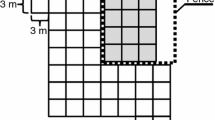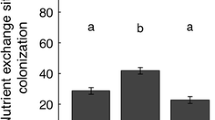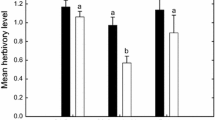Abstract
Using an exclosure experiment in the willow stage of primary succession on the floodplain of the Tanana River, we tested the hypothesis that browsing can reduce mycorrhizal infection. We measured the effects winter browsing by moose (Alcesalces) and snowshoe hare (Lepusamericanus) had on mycorrhizal infection and fine root biomass of willow (Salix spp.) and balsam poplar (Populusbalsamifera). We found that protection from winter browsing increased ectomycorrhizal infection by 10% in the top 5 cm of the soil profile, by 23% at 5–10 cm, and by 42% at the 10–15 cm depth. Mammal browsing in taiga forests is now recognized as a major cause of the shift from palatable deciduous species such as willow and balsam poplar to less palatable species such as alder and spruce. We suggest that browsing-induced reduction in ectomycorrhizal infection of salicaceous species plays a central role in this shift in plant community composition.
Similar content being viewed by others
Author information
Authors and Affiliations
Additional information
Received: 26 March 1996 / Accepted: 26 September 1996
Rights and permissions
About this article
Cite this article
Rossow, L., Bryant, J. & Kielland, K. Effects of above-ground browsing by mammals on mycorrhizal infection in an early successional taiga ecosystem. Oecologia 110, 94–98 (1997). https://doi.org/10.1007/s004420050137
Issue Date:
DOI: https://doi.org/10.1007/s004420050137




